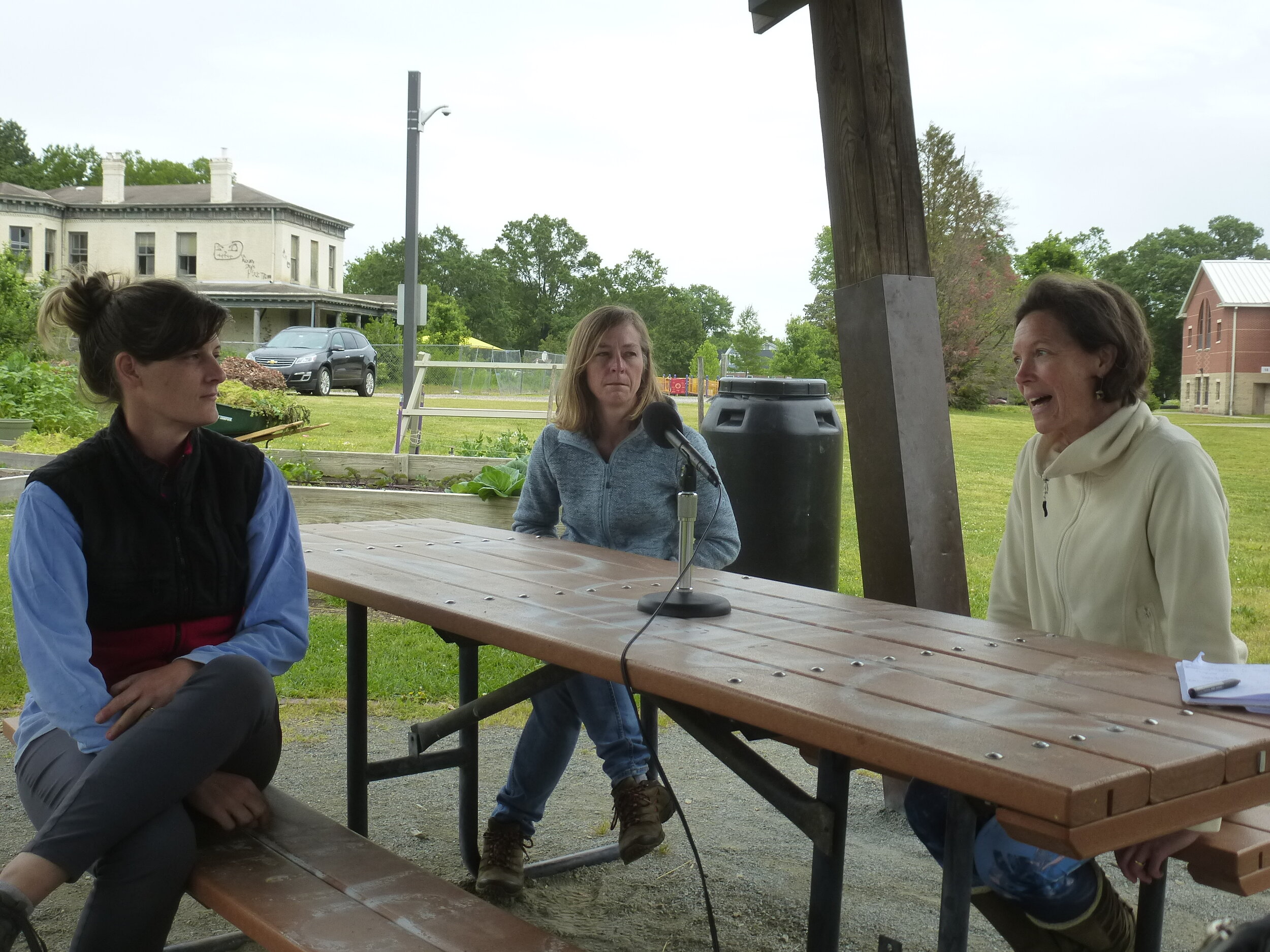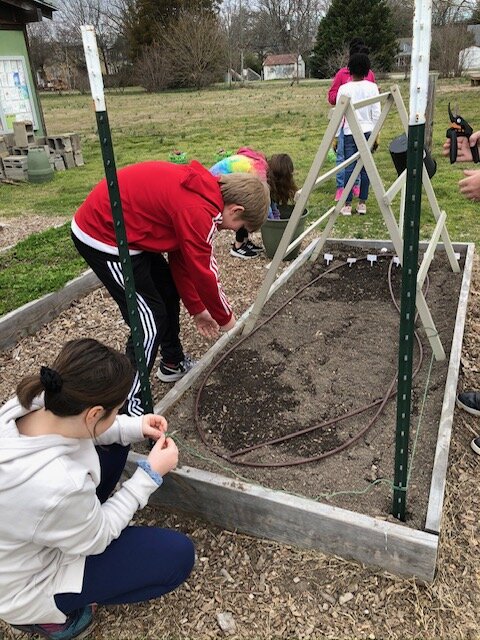The Dandelion Garden
An Outdoor Classroom
by Charles McGuigan 06.2020
Back in mid-May, shortly after noon, and the temperature unseasonably cool, I met up with three women who nurture The Dandelion at Holton Elementary School. Two of them—Ellen Shepard and Susanna Raffenot, the OGs, or Original Gardeners, as they’re sometimes called—planted the initial seeds, almost ten years ago to the day, for a project that has frankly surprised this pair of progenitors. The other woman is Kate Lainhart who now works as the garden educator at Holton Elementary School. She’s the teacher who uses hands-on nature as her classroom, showing her charges how important it is to care for our planet, relating it to other courses of study.
Holton students planting seeds in The Dandelion.
It is fitting that we are seated at safe social distances on picnic benches under the roof of The Hudson House, named for the man who made this singular project possible. Principal David Hudson gave the okay for Ellen and Susanna to proceed with the project, and threw his full weight behind it. On about the time The Dandelion was dedicated, Mr. Hudson was named Principal of the Year by RPS. Along with a plaque, he received a $7,500 cash award, and being David Hudson, he donated the entire sum to The Dandelion project.
“Bon Secours and the Holton PTA also gave us big chunks of money,” Ellen said. “As well as the Family Foundation, Lowe’s and individual donors.”
Susanna remembered the moment she first came up with the idea of a teaching garden. “I was at the Holton 5 K Family Festival, helping to put together all the activities for that, and I was spending a lot of time out back here,” she told me. “And I kept looking at these old beds that were there over by the bus loop. They were just kind of run down, and I thought, let’s throw some pansies in there to spruce them up a little bit.”
That night, she took to Google and discovered an entire movement devoted to school gardens thanks in large part to a truly remarkable First Lady, Michelle Obama. “The White House had started planting their garden that same year,” said Susanna. So she planted the seed in the minds of other parents who had children at Holton, and was amazed at how rapidly it germinated. “As you know, this community is just so fabulous once you put an idea out there,” Susanna said. “There was instant support around the idea, including Ellen Shepard here who was super excited about it and she just really took the ball and ran with it.”
That summer, the pair attended a symposium on youth gardening held in Cleveland, Ohio. “And that just kind of opened our eyes up to what possibilities were out there,” Susanna recalled. “I think what we came away with were these things: Use your own space, know what your strengths are, adopt and develop it, know where your community resources are, and know who your school support is, like the principal and the staff.”
Then in April of 2010, not long after the worst environmental disaster in U.S. history when a petroleum company in its quest to fatten corporate gains damned near destroyed the Gulf of Mexico, The Dandelion was formally dedicated. Among those present were former Governor Tim Kaine and First Lady Anne Holton.
Back then, I talked with Chris Chase, a sculptor and carpenter, who designed the Hudson House, this outdoor classroom which is the omphalous of The Dandelion.
It is an elegant essay in post-and-beam construction with massive upright members sheathed in copper supporting an array of joists fitted at various angles.
“I just sort of played around with it,” Chris had told me a decade ago. “I just took that metaphor of a butterfly and went with it. I tried to be as organic as I could, using as minimal an amount of materials as possible.”
Susanna Raffenot looked up at the ceiling of the Hudson House. “This place is hurricane proof and Chris really developed it to be in commune with the gardens,” she said. “It’s got six legs, it’s got a winged roof. It’s got a light membrane roof to protect from sun and light rain, and he also developed little spouts so we could collect rainwater off the corners, so we’ve got rain barrels surrounding it. And it opens up into the butterfly garden, our pollinator garden, which is in the shape of a butterfly.”
That garden is filled with native plants—Joe Pye weed, highbush blueberry, milkweed, purple coneflower, mountain mint, golden rod, bee balm, rudbekia, and more
Because of the massive community support from the school and beyond, The Dandelion continued to grow. “We added the garden shed, a composting station, the bluebird trail,” said Susanna. “And we just couldn’t say no. So we kept on going and it was a lot of work in the beginning, but we also had a lot of resources.”
With a grant from The Chesapeake Bay Foundation, they were also able to construct a rain garden. Located on the island in the parking lot at the front of the school, this garden of native plant species cleanses runoff water before it is returned to the Chesapeake Bay watershed.
To prepare the spot for the rain garden, tons of fill-dirt was removed and replaced with appropriate layers of clay, sand and soil. And then plantings were made.
“There are bald cypress, native grasses, and two bay magnolias,” Ellen Shepard said. “I think there are in the neighborhood of a hundred and fifty plants out there. In the City of Richmond we have terrible pollution problems, and so the rain garden helps control both the quality and the quantity of water that is running off, collecting from 1.8 acres of run off between the roof and the pavement and the compacted soil. It is a monster rain garden.”
Kate Lainhart, Ellen Shepard, and Susanna Raffenot in the Hudson House.
Ellen remembered the day of the ground-breaking for the rain garden. Governor Linwood Holton, who had just turned ninety, drove himself to the school and delivered a speech. “He talked about environmental stewardship and this diverse school,” said Ellen. “And the kids sang Happy Birthday to him and got to meet the man their school is named after. It really was one of the highlights of this entire gardening project.”
On the opposite end of the school property, The Dandelion Garden has created something of a forest, another example of good land stewardship.
“Over the years, we have planted 363 trees, most of them natives,” according to Ellen. “We have mulberry, button bush, indigo, hazelnut, honey locust, sycamore.”
Susanna nodded as Ellen listed the trees. “We know trees are the most cost-effective thing to do to fight climate change and suck up carbon,” she said. “They are the key.”
And those trees have a number of other functions. “They form a natural boundary,” Susanna said. “And what I love about them is that they block out the road noises and buffer the wind a bit. And there are so many birds and other native animals that take shelter in there.”
All of these features make The Dandelion the most unique outdoor classroom imaginable, and Kate Lainhart uses it all to full effect. Her son had started attending Holton three years ago, and Kate, who has a background in agriculture, began volunteering. This past year she started working at Holton as the school’s garden educator. All school year long, she sees all 600 students who attend Holton over every two-week period. “So every child comes out every other week,” Kate said. “I come up with a curriculum that involves either math or science, or another subject. Or just getting dirty. We do everything from planting, weeding, watering to harvesting. We do experiments. We do observations. Sometimes we just sit here really quietly and listen.”
And the grounds are large enough and harbor enough diversity that the kids can actually go on nature hikes. “We did a seed hike one day around our amazing school,” Kate explained. “We found as many seeds as we could, which with all of our trees and bushes and shrubs and flowers wasn’t hard to do.”
Kate looked around her, and then said, “This is my classroom. On a freezing day or a rainy day I do go inside and teach the class inside each individual class’s classroom. But, I would prefer to be out here all the time.”
The kids have noticed Kate’s attachment to the outdoor classroom. If they see her in the halls, they’ll ask very seriously, “What are you doing inside?” And some of the students believe she might live in the potting shed. “Do you live in there?” they’ll ask.
Only when the weather is extremely inclement, will Kate move to the indoors. “Richmond is amazing because from day to day it can be twenty and the next day it can be forty,” she said. “If it’s above freezing, I really want them to be out there. I try to get them to move their bodies and not just sit around.”
Kate’s position at Holton is funded neither by RPS nor the PTA. “It is a crow-funded,” Ellen Shepard said. “So, we’re always looking for contributions. Sara Hendricks (who has two daughters attending Holton) is kind of our fund-raiser. Our school has recognized that this is an important part of our curriculum and our community.”
Preparing a raised garden bed.
One of the major components of The Dandelion will always be the produce gardens. Before COVID-19 struck, students had already begun planting crops, everything from carrots and radishes, to leaf crops and strawberries.
“We let the students plant and harvest, to see how that whole process is from start to finish,” Susanna said. “Because then you’re invested in it, working with it and watching it grow, you really care for it.”
And though the students have been unable to reap the rewards of their labor, Kate is diligent about tending the raised beds, and collecting the crops.
“Since school has been out, I have been coming every week and harvesting and taking that over to the Ginter Park Elementary School Food Distribution Center,” said Kate. “Since March I have taken thirty-six bags of salad mix, twenty-tree bags of spinach, thirty-three bags of herbs, nine bunches of radishes, twenty-five bunches of carrots and elven heads of Romaine lettuce. I will continue to do that until school is officially out.”
Susanna Raffenot had to leave for a remote meeting, but before she did, she stood up and walked over to the Butterfly Garden, and looked over to the trees and back to the raised beds and The Hudson House.
“I’m blown away looking at how much greenery there is now, how much fill in, and I keep going back to that empty field that was here ten years ago,” she said. “People need to see what a huge difference this has been. I think of the number of people and the dedication and the time that went into this. And it just keeps growing.”
If you’d like to make a donation or volunteer your time, please contact Kate Lainhart at lainhartk@gmail.com , Ellen Shepard at ellenshepard@yahoo.com or Susanna Raffenot at sraffenot@verizon.net



